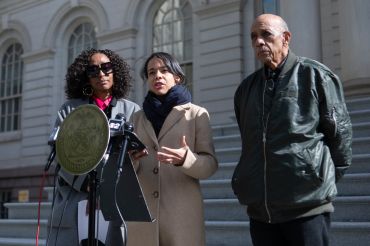How the Biden Infrastructure Bill Can Be Used to Fund Housing
The landmark 2021 legislation wasn’t aimed at America’s historic housing shortage but there are billions of dollars for developers to tap
By Chava Gourarie January 24, 2024 1:57 pm
reprints
The $1.2 trillion bipartisan infrastructure bill that passed in 2021 was not designed to address housing.
The Infrastructure Investment and Jobs Act (IIJA) was meant to remake America’s transportation and energy infrastructure over the next decade, by bringing roads and bridges up to speed, advancing clean energy development, and investing in advanced manufacturing such as EV battery production.
But transportation and housing are fundamentally intertwined, and as cities begin to invest in major transit projects that will reshape them for decades, it only makes sense to consider how housing fits into the picture. Housing with access to public transportation boosts affordability, because it provides residents with access to jobs and services without having to incur the cost of a car. In turn, housing density near transit helps spur ridership.
“Access to transportation is one of the key aspects of housing affordability,” said Yonah Freemark, a housing policy researcher at policy think tank Urban Institute and the author of a paper on the subject, titled “Achieving Housing Abundance Near Transit.”
Transit-oriented housing advocates like Freemark, as well as the Biden administration, are therefore looking to leverage the $566 billion of transportation funds being funneled to local governments through the IIJA to address the current housing crisis.
In fact, in October, the Biden administration announced that it would support the conversion of vacant offices into housing, with much of the funding coming from the Department of Transportation (DOT), newly flush from the infrastructure bill. In conjunction with Biden’s announcement, DOT released new guidance making conversions from vacant office space to housing an eligible project type for certain kinds of funding.
“I was heartened to see that at least the White House came out with that,” said Ron Gart, a real estate partner at law firm Seyfarth Shaw and member of trade group The Real Estate Roundtable. ”In October they came out and said we have these existing programs, but now we want to make it clear they can be used for conversions.”
Reversing sprawl
The disconnect between housing and transportation is a hallmark of the American system, given its post-World War II reliance on sprawl and the personal vehicle. That’s hard to undo.
“One of the challenges we face is that in the past, and still today, the majority of new housing is in low-density areas. That has been our approach as a nation to accommodate more housing supply,” said Freemark. “You especially see it now in where new housing is really being permitted — a vast amount in Texas, for example — and those permits are in exurban locations that are incredibly bad for the environment.”
Still, there has been a growing — albeit marginal — shift in attitude, as cities begin to consider density, walkability and transit-oriented planning as a benefit. This is partly due to the extreme housing shortage throughout the U.S. as well as the recognition of the detrimental environmental impact of cars.
“There are plentiful opportunities for cities of all sizes to improve access to transportation, and link that to higher-density housing,” said Freemark.
For example, larger metropolitan areas like Seattle and Washington, D.C. — in conjunction with their respective regional transportation authorities — have utilized both federal and local programs to incentivize development as they expand their commuter rail networks. Smaller cities like Spokane, Wash., and Richmond, Va., are investing in rapid bus systems, to make buses more frequent and reliable.
“Cities like that should be thinking about how to link those investments in rapid bus lines with affordable housing,” Freemark said. “That’s the ideal.”
Some transportation planning departments have also begun using the “vehicle miles traveled” (VMT) metric as a measure of success or progress — such that fewer miles traveled is considered a virtue. Thus far, the only state DOT to require a reduction in VMT for certain projects is California, but states such as Colorado and Minnesota require that transportation agencies account for their carbon emissions — of which VMT is an important factor — and potentially mitigate them.
Bridging transit and housing
At the federal level, the new guidance from DOT and some programs within IIJA are working to bypass the disconnect between transit and housing.
The biggest obstacle is that infrastructure funds are generally directed to state or regional transit agencies, which are independent of the local government agencies dedicated to housing. That can make it difficult for transit and housing officials to collaborate.
“That means that, fundamentally, you have different actors making these choices,” said Freemark. “It’s even worse outside major cities.”
In the IIJA, there was an effort to link transit and housing via metropolitan planning organizations (MPOs), which oversee regional transportation plans, by introducing Housing Coordination Plans. MPOs would coordinate between housing, transportation and economic development agencies to create a list of regional infrastructure projects. In order to deploy federal funding, the MPOs would prioritize projects that address other local issues, such as housing affordability or supply.
Another way that the federal government has attempted to support housing through IIJA is through its many competitive grant programs.
Of the total infrastructure funds available, about 75 percent is distributed directly to various federal agencies, and 25 percent through competitive grant programs. The DOT has at least $76 billion in funds to distribute via a variety of grant programs — over which it has considerable discretion on how to condition the allocation of the funds.
According to the DOT, projects applying for funds through the Rebuilding American Infrastructure with Sustainability and Equity (RAISE) program will be judged on their impact on housing, in addition to other criteria. That particular program, initially created in 2009, has $1.5 billion in the pot for 2024.
Low-interest loans
The DOT’s main avenue for funding housing development is via the $35 billion it has available to fund transit-oriented development through low-interest loans via the Transportation Infrastructure Finance and Innovation Act (TIFIA) and the Railroad Rehabilitation & Improvement Financing (RRIF) programs — two programs that have existed since the 1990s.
Under both programs, funds can be made available for developers, in addition to local governments, for eligible projects that include commercial and residential development near transit. Office-to-residential conversions are now considered an eligible project type under the new DOT guidelines.
TIFIA projects can be fully private but must have a public infrastructure benefit, and can finance up to 49 percent of costs for projects with a minimum cost of $10 million. “They want to see some public association,” explained Gart. “If you have all your zoning entitlements, that’s good enough to show that your government is behind this.”
RRIF projects on the other hand are usually public-private partnerships and must contribute to ridership or revenue of the relevant transit station — an argument that most housing developments can make. There is no minimum or maximum cost for a project to be eligible for RRIF funding, but there are more restrictions on what the funds can be used for.
Under both programs, projects have no affordability requirements, although they may contribute to housing affordability by virtue of increasing supply. However, DOT’s new guidance allows transit agencies to transfer properties at no cost to local governments or developers for affordable housing projects specifically.
While these programs will certainly provide a boost to developers, it could be years before the impact will be felt, and it will take awhile for the funds to be deployed as well. “While the programs have been in place for about two years, the reality is they’re learning as they’re going,” Gart said. “Right now it’s taking about 15 months to underwrite a project.”
Joint development
Transit agencies often have underused land that was initially purchased for staging during large infrastructure projects, managed by the Federal Transit Administration, a subagency of the DOT.
While regional transit funds can’t be used to build housing directly, these sites may be transferred to local jurisdictions or private developers for housing development under certain conditions, in what’s known as joint development. Eligible projects have to be physically adjacent to transit infrastructure, enhance ridership, and contribute some revenue back to the agency.
“Both DOT and the GSA [General Services Administration] have now been given authority, if you will, to convey surplus properties,” said Gart. “The DOT is permitting transit agencies to convey land to local, nonprofit or for-profit affordable developers.”
Both Sound Transit, and WMATA, the respective transit agencies for the Seattle and Washington, D.C., metro areas, have utilized these lands to build thousands of housing units near light rail stations. Sound Transit has been particularly active in the last several years, facilitating the development of 3,100 units near its Link stations, of which roughly 75 percent are affordable, per the agency.
However, many of these properties were acquired using federal funds, and the transit agencies have traditionally been required to pay back the federal government if they dispose of the land. Some agencies get around that using leaseholds, or other structures, but it often serves as a barrier.
One little known but potentially profitable workaround was introduced via the National Defense Authorization Act (NDAA) in 2022, according to Freemark’s report. The NDAA includes an option in which regional transit agencies that lease or sell underused lands for affordable housing development can sidestep the requirement to pay back the federal government.
Overall, DOT has 21 different programs, each with their own criteria for funding various types of development. So the federal focus on housing can lead to incremental shifts, as the agencies prioritize projects with a housing component.
“Even DOT would love to see an area where a city has a parking lot, that is then ground leased to a developer who then builds an apartment building,” said Gart.
Chava Gourarie can be reached at cgourarie@commercialobserver.com.


